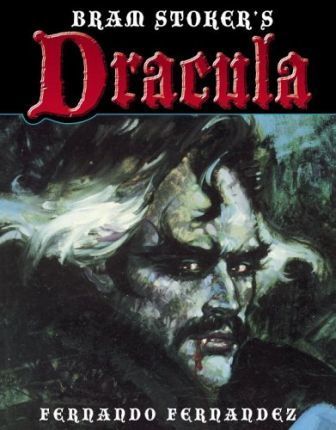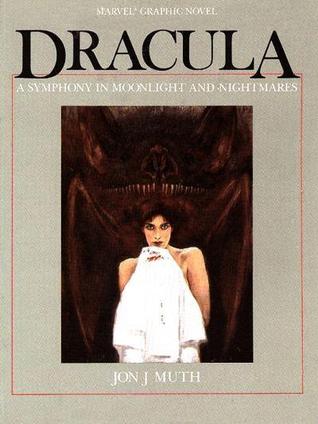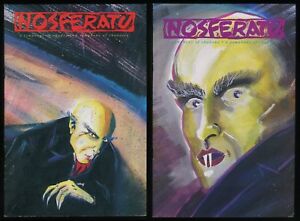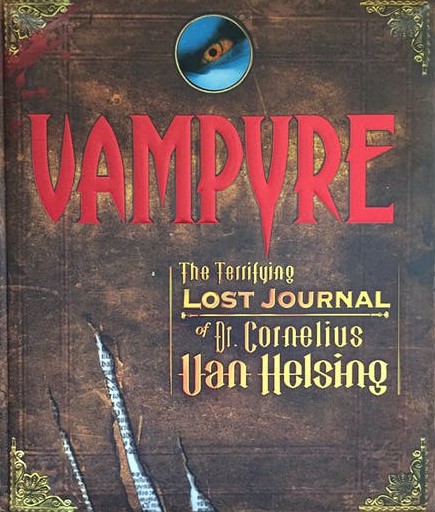Surely you know DRACULA, a seemingly everlasting pop culture phenomenon that began as an 1897 novel by Bram Stoker. That novel has gone through innumerable editions and been adapted for seemingly just as many movies. Film makers and artists have invested countless hours into creating Dracula’s unforgettable image, and various graphic novels about Dracula have gained popularity of late. The following is not a comprehensive listing of all the appearances of DRACULA—and its unauthorized offspring NOSFERATU—in the graphic medium, just four publications that I feel are among the more noteworthy examples.
 BRAM STOKER’S DRACULA is a 96-page graphic novel adapted and illustrated by the Spanish artist FERNANDO FERNANDEZ back in 1984 (and reprinted in 2005 by Del Rey). Done up in sumptuous watercolor paintings, it’s a damn good looking saga—I’d even go so far as to call it one of the most impressively visualized graphic novels I’ve seen. The problem is the pictures, divided into traditional rectangular panels, work better as self-contained art pieces than as parts of a larger whole.
BRAM STOKER’S DRACULA is a 96-page graphic novel adapted and illustrated by the Spanish artist FERNANDO FERNANDEZ back in 1984 (and reprinted in 2005 by Del Rey). Done up in sumptuous watercolor paintings, it’s a damn good looking saga—I’d even go so far as to call it one of the most impressively visualized graphic novels I’ve seen. The problem is the pictures, divided into traditional rectangular panels, work better as self-contained art pieces than as parts of a larger whole.
Based on what I recall of the Stoker novel, Fernandez follows it fairly closely. BRAM STOKER’S DRACULA begins like the novel, with Jonathan Harker’s trip to the scary Transylvanian castle of Count Dracula, a centuries-old vampire. Harker is left prey to Dracula’s trio of bloodsucking ho’s, but escapes. He’s too late, though, to stop Dracula from traveling back to Harker’s hometown, where he puts his spell on Harker’s fiancée Mina and her friend Lucy. The latter ends up becoming vampirized and meets a hideous fate. Also along for the ride are the nutty Renfield and the heroic vampire hunter Dr. Van Helsing.
You get the drift: Fernando Fernandez has crafted a loving tribute to an enduring classic. His DRACULA is impressive, but could have used a bolder, more individual approach.
That’s definitely not a complaint I can make about DRACULA: A SYMPHONY IN MOONLIGHT  AND NIGHTMARES, written and illustrated by JON J. MUTH (and published by Marvel), which is disappointing for other reasons. Again we have some sumptuous imagery—Muth’s dreamy watercolors (also on display in comics like MOONSHADOW and M) have a druggy, nightmarish beauty. Narrative-wise, though, this Dracula is a bit of a hodge-podge. Rather than relate his story in comic form Muth provides straightforward text to move it along, but he’s definitely at his best with visual montages.
AND NIGHTMARES, written and illustrated by JON J. MUTH (and published by Marvel), which is disappointing for other reasons. Again we have some sumptuous imagery—Muth’s dreamy watercolors (also on display in comics like MOONSHADOW and M) have a druggy, nightmarish beauty. Narrative-wise, though, this Dracula is a bit of a hodge-podge. Rather than relate his story in comic form Muth provides straightforward text to move it along, but he’s definitely at his best with visual montages.
Muth follows the original DRACULA fairly closely, but in disjointed, perfunctory fashion. The character of Jonathan Harker is all-but jettisoned, and here it’s Mina rather than Lucy who becomes Dracula’s bitch. Muth also ends the story differently, by having Lucy run off with Dracula. The verdict: unsatisfying, though the artwork is fantastic.
 Next up is NOSFERATU from 1991, a 2-issue Tome Press comic adaptation of F.W. Murneau’s legendary 1922 film, which was an outright plagiarization of DRACULA. RAFAEL NIEVES and KEN HOLEWCZYNSKI have replaced Murneau’s painterly visuals with black and white imagery rendered more often than not as (oft-indistinct) lines and shapes amidst a sea of darkness.
Next up is NOSFERATU from 1991, a 2-issue Tome Press comic adaptation of F.W. Murneau’s legendary 1922 film, which was an outright plagiarization of DRACULA. RAFAEL NIEVES and KEN HOLEWCZYNSKI have replaced Murneau’s painterly visuals with black and white imagery rendered more often than not as (oft-indistinct) lines and shapes amidst a sea of darkness.
The film was an expressionistic image-fest that condensed the events of DRACULA considerably, and added an overpowering emphasis on disease and decay. That last point is evident in the film’s presentation of Count Orloc, the Dracula stand-in played unforgettably by Max Schreck. The latter is made up like, in essence, a two-legged rat, with pasty skin, pointy ears and two formidable fangs jutting from the center of his mouth. That figure is faithfully replicated by Nieves and Holewczynski, who also do a good job visualizing the film’s set and locations. They’ve filled out the story by borrowing Bram Stoker’s conceit of relating it through a supporting character’s journal entries (something that wasn’t part of the Murneau film) and jimmied with the chronology somewhat, but otherwise the comic follows the film nearly verbatim.
Last we have VAMPYRE, THE TERRIFYING LOST JOURNAL OF DR. CORNELIUS VAN HELSING (Harper Collins) from author MARY-JANE KNIGHT and illustrators GARY BLYTHE, PHILIP JACOBS and MIKE PETERKIN. It’s one of those mock scrapbooks that have become popular in recent years (usually compiled by the likes of Nick Bantock) in which the heavily illustrated pages are affixed with maps, tickets, envelopes and the occasional pop-up image. All are in service of a journal by Dr. Van Helsing, who as the book starts is journeying to Transylvania in search of a cure for his brother’s mysterious illness. It takes place directly after the events of DRACULA, with the count staked and out of the picture—or so it seems.
and illustrators GARY BLYTHE, PHILIP JACOBS and MIKE PETERKIN. It’s one of those mock scrapbooks that have become popular in recent years (usually compiled by the likes of Nick Bantock) in which the heavily illustrated pages are affixed with maps, tickets, envelopes and the occasional pop-up image. All are in service of a journal by Dr. Van Helsing, who as the book starts is journeying to Transylvania in search of a cure for his brother’s mysterious illness. It takes place directly after the events of DRACULA, with the count staked and out of the picture—or so it seems.
As a stand-alone story this book has little to offer, but the narrative works in (and only in) conjunction with the overall layout. The diary entries, you’ll note, are bolstered by the scribblings of Van Helsing’s cranky assistant Gustav—and by a mysterious third party who goes by “D” and makes a fateful appearance on the final page. A fun, fast read and, best of all, it can currently be found on remainder shelves for around three bucks.
